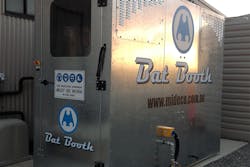Dust control PPE for pharmaceutical industry workers
Problem
According to the World Health Organization, every year in both developed and developing countries overexposure to dusts causes disease, temporary and permanent disabilities and deaths. The Medical Journal of Australia estimates that about 15 percent of adult-onset asthma, 15 percent of chronic obstructive pulmonary disease and 10 to 30 percent of lung cancer internationally may be attributable to hazardous occupational exposures.
Manufacturing and distribution of pharmaceutical products such as drugs, vitamins, minerals or herbs involves a wide range of processes that can generate harmful dust. The pharmaceutical dust can present harmful effects to workers, pose chemical hazards and contaminate the product. This is a growing industry with an ongoing demand for appropriate dust control tools and effective personal protective equipment (PPE).
Solution
There are various types of equipment and PPE that can assist with dust control and meet employers’ legal responsibility to protect workers. During the manufacturing of pharmaceutical products, companies often use dust collectors; the product handling and transportation require dust suppression systems; and staff on site must wear appropriate uniforms, masks and gloves to be adequately protected. But what happens after they leave the site, even temporarily? The dust remains on their clothes and often is simply redistributed after being blown off. The failure to properly remove dust from workers’ uniforms during breaks and immediately after shifts can lead to a higher overall levels of harmful dust inhaled.
What’s needed is a system that permanently removes dust from workers’ clothing and therefore reduces the risk of developing harmful health conditions. To meet this need, Australian company Mideco developed a personnel de-dusting booth, branded the BatBooth that removes up to 80 percent of dust in seconds.
How does de-dusting work?
The compressed air inside the booth is used to blow dust off the contaminated clothing. The dust is then captured and contained via a special filtering system. The booth is equipped with efficient HEPA filters that meet U.S. National Institute for Occupational Safety and Health (NIOSH) standards. A dust control system with such filters is effective even against the smallest dust particles — silica — which are the most dangerous.
Advantages
The de-dusting process takes 10 to 12 seconds and tests have shown a 50 percent improvement in dust removed from clothes over other methods. Other solutions use single-point air hoses that usually provide only temporary relief.
Another advantage of this new design is that the dust collected during the process doesn’t escape from filter cartridges. That makes the solution safe for the environment, allowing installation inside of a building, tunnel or underground.
Installation
This dust removal system is designed as a standalone unit that comes assembled on a skid base and is operational almost immediately. All that is required is compressed air and a power connection. Once on site, it can be used multiple times per day. It dramatically reduces the time required to clean the uniform and decreases costs associated with occupational health and safety (OHS).
Applications
Such a system is ideal for any industrial or processing environment where dust contamination poses a health hazard, whether it is pharmaceutical manufacturing, handling or transportation.
It is evident that the growing pharmaceutical industry’s need for efficient dust control solutions and effective PPE will continue to increase. Effectively removing dust and requiring proper PPE can help pharmaceutical manufacturers ensure their workers’ health is not compromised.
Melton White joined Mideco company in 1994 and worked his way up from a sales representative to the CEO in 2004. He graduated from Swinburne University with a bachelor’s degree in business. White is also the person behind Mideco’s Bat Booth™ de-dusting system launched in 2014. The system has been installed at multiple work sites in Australia, Canada and the U.S. and has received multiple industry safety awards.
